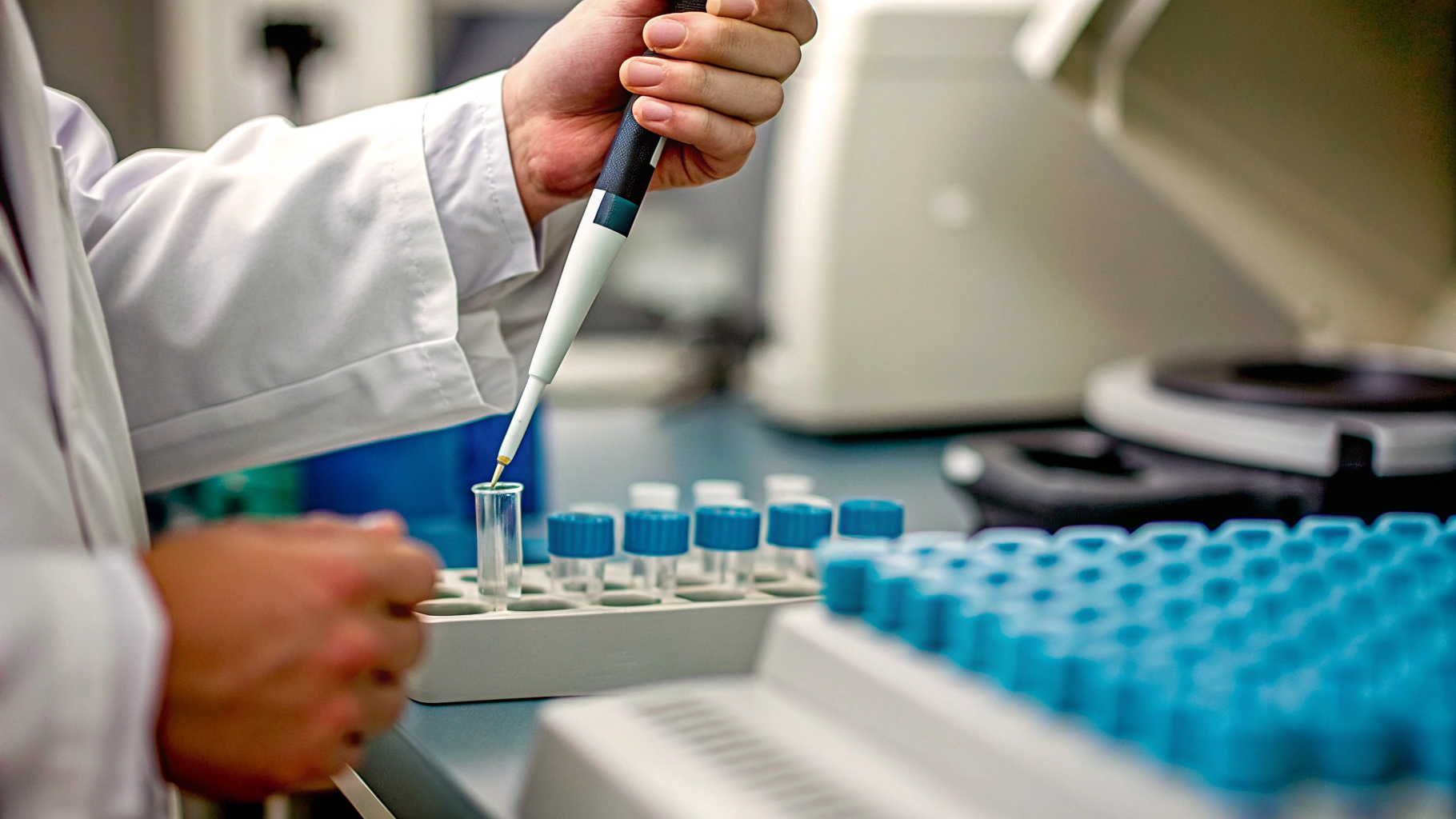What Is In Vitro Diagnostics? Importance and Key Insights for Compliance Officers

Overview
In vitro diagnostics (IVDs) represent a critical component of healthcare, involving essential evaluations conducted on human samples such as blood or urine. These assessments are pivotal for identifying illnesses and guiding treatment decisions, ultimately influencing clinical outcomes. Notably, diagnostics play a role in approximately 70% of medical decisions, underscoring their significance in early disease detection and personalized medicine. This is crucial for enhancing patient care and optimizing healthcare resources.
The impact of IVDs extends beyond mere identification; they are instrumental in shaping treatment pathways and improving patient outcomes. By facilitating early detection of diseases, IVDs empower healthcare providers to tailor interventions that meet individual patient needs. This personalized approach not only enhances the quality of care but also contributes to more efficient use of healthcare resources.
As we navigate the complexities of modern medicine, the importance of IVDs cannot be overstated. They serve as a foundation for informed medical decisions, ultimately driving better health outcomes and fostering a more effective healthcare system. Engaging with compliance solutions related to IVDs is essential for healthcare professionals aiming to leverage these tools effectively.
Introduction
In a landscape where timely and accurate medical interventions can mean the difference between life and death, in vitro diagnostics (IVD) stands as a cornerstone of modern healthcare. These tests analyze samples from the human body, informing critical medical decisions essential for identifying and monitoring diseases. Moreover, they play a pivotal role in personalized medicine. However, as the IVD landscape evolves, compliance officers encounter the pressing challenge of navigating complex regulatory frameworks while ensuring the highest standards of patient care.
How can organizations effectively adapt to these changes and harness the full potential of in vitro diagnostics? This question underscores the need for robust compliance solutions that not only meet regulatory demands but also enhance patient outcomes. By embracing innovative strategies and leveraging industry expertise, organizations can turn compliance challenges into opportunities for growth and excellence in patient care.
Define In Vitro Diagnostics and Its Significance
What is in vitro diagnostics involves evaluations performed on samples such as blood, urine, or tissue collected from the human body. To understand what is in vitro diagnostics, it is important to note that these evaluations, conducted externally, are essential for identifying illnesses, monitoring health, and guiding treatment decisions. What is in vitro diagnostics is significant because it provides critical information that can lead to timely and accurate medical interventions. As the medical landscape evolves, the role of IVD becomes increasingly vital, particularly in personalized medicine and disease prevention strategies.
Research indicates that diagnostic tests influence approximately 70% of clinical decisions, underscoring their crucial role in medical service delivery. Notably, diagnostics accounted for around 1.6% of total Medicare expenses, highlighting the financial implications of in vitro devices in healthcare. Furthermore, what is in vitro diagnostics costs represent 2.3% of total healthcare expenditure (HCE) in the US, providing a broader context for understanding the financial impact.
Early identification through what is in vitro diagnostics has been shown to reduce mortality rates for conditions such as Hepatocellular Carcinoma by 37%, emphasizing their importance in disease prevention and management. Expert insights further reinforce the significance of IVD, with Dr. Mariângela Simão from the World Health Organization stating that 'testing influences most medical decisions.' The WHO emphasizes what is in vitro diagnostics as being crucial for achieving favorable health outcomes, particularly in routine medical practice and emergency situations. As the demand for customized healthcare solutions grows, the role of in vitro diagnostics in enhancing patient care and optimizing treatment pathways will remain a vital focus for compliance officers and healthcare stakeholders alike.

Explore Types of In Vitro Diagnostics
In vitro diagnostics (IVDs) play a crucial role in patient care, encompassing a variety of testing methodologies that can be categorized into several key types:
-
Clinical Chemistry Tests: These tests evaluate bodily fluids to monitor organ function and diagnose diseases. For instance, blood glucose assessments are critical for diabetes management, while liver function evaluations assess hepatic health. Given the rising occurrence of chronic conditions and the need for early diagnosis, the clinical chemistry segment is poised to sustain a notable market share.
-
Microbiological Assessments: These evaluations are pivotal in identifying pathogens within clinical samples. Blood cultures, for example, are routinely employed in hospitals to detect infections such as sepsis. The microbiological testing market is expected to expand, driven by the increasing prevalence of infectious conditions and the demand for swift diagnostic techniques.
-
Molecular Diagnostics: This category includes sophisticated assessments that examine genetic material. Polymerase chain reaction (PCR) analyses, for instance, are utilized to identify specific DNA sequences associated with various conditions. The molecular diagnostics market is experiencing robust growth, fueled by innovations in testing technologies and a heightened focus on personalized medicine.
-
Immunoassays: Utilizing antibodies to detect specific proteins or hormones, immunoassays are widely used in clinical settings. Examples include pregnancy tests and tests for infectious diseases like HIV. This segment remains a leader in the IVD market, supported by ongoing advancements in assay development and increased demand for point-of-care testing.
Understanding these distinctions is crucial for compliance officers. Each type of IVD is subject to specific regulatory frameworks that ensure safety and efficacy. The evolving landscape of what is in vitro diagnostics, marked by technological advancements and regulatory changes, necessitates a proactive approach to compliance management. How prepared is your organization to navigate these complexities? Engaging with AVS Life Sciences can provide the expertise needed to ensure compliance and enhance patient care.

Understand Regulatory Framework for In Vitro Diagnostics
The regulatory environment for in vitro tests is complex and varies significantly across regions. In the United States, the Food and Drug Administration (FDA) serves as the primary authority overseeing the approval and regulation of what is in vitro diagnostics. These diagnostics are classified into three categories based on their associated risk levels.
- Class I devices, deemed low-risk, face the least regulatory oversight.
- Class III devices, which present a higher risk to patients, require stringent premarket approval processes.
Notably, statistics reveal that nearly 70% of medical decisions hinge on laboratory test outcomes, underscoring what is in vitro diagnostics' critical role in healthcare.
Globally, standards such as ISO 13485 play a vital role in establishing quality management systems for medical devices, which includes understanding what is in vitro diagnostics. This standard ensures that organizations uphold consistent quality in their products and services, which is essential for meeting regulatory requirements. Compliance officers must skillfully navigate these regulations to ensure their organizations fulfill all necessary criteria for safety, efficacy, and quality.
In light of these challenges, organizations must prioritize compliance solutions that not only meet regulatory demands but also enhance operational efficiency. Engaging with experts in compliance can provide invaluable insights and strategies tailored to specific needs. By fostering a culture of compliance, organizations can not only mitigate risks but also position themselves as leaders in the industry.
Ultimately, the path to effective compliance in the realm of what is in vitro diagnostics is paved with knowledge, strategic planning, and a commitment to quality. Are you ready to take the next step towards ensuring your organization meets these critical standards?
Highlight Benefits and Applications of In Vitro Diagnostics
In vitro diagnostics (IVDs) offer a multitude of significant benefits that are reshaping healthcare delivery:
- Early Detection: IVDs enable the timely identification of diseases, which is essential for initiating effective treatment strategies. Early diagnosis can dramatically enhance patient outcomes, allowing for interventions before conditions worsen.
- Personalized Medicine: Understanding what is in vitro diagnostics is crucial, as these diagnostics provide detailed insights into a patient's unique health profile. This information empowers medical providers to develop tailored treatment plans, thereby improving therapeutic effectiveness and optimizing patient care.
- Cost-effectiveness: In healthcare, this can be understood by exploring what is in vitro diagnostics, as they help reduce medical expenses through accurate diagnoses. They minimize unnecessary procedures and hospital stays, leading to more efficient resource utilization and better allocation of medical funds. Notably, testing influences 70% of clinical decisions while accounting for less than 3% of healthcare expenditures, which underscores what is in vitro diagnostics as a substantial value proposition.
- Public Health Monitoring: What is in vitro diagnostics plays a vital role in tracking infectious diseases and outbreaks, thus supporting public health initiatives. Their role in monitoring health trends is crucial for timely responses to emerging health threats.
As the in vitro diagnostics sector is projected to reach USD 141.9 billion by 2029, with an estimated market value of USD 94.7 billion in 2024 and a compound annual growth rate (CAGR) of 8.4%, compliance officers must prioritize adherence to regulatory standards in the development and application of IVD tests. This commitment not only maximizes the benefits of IVDs but also safeguards patient safety and well-being. Furthermore, understanding the FDA's criteria for enforcement discretion is essential for maintaining compliance and effectively navigating the regulatory landscape.
Conclusion
In vitro diagnostics (IVDs) stand as a cornerstone of modern healthcare, providing essential evaluations that inform medical decisions and enhance patient outcomes. These diagnostics, derived from samples such as blood and tissue, are crucial for identifying diseases, monitoring health, and guiding treatment strategies. As personalized medicine and disease prevention gain prominence, the significance of IVDs continues to grow, underscoring their role in delivering timely and precise medical interventions.
Key insights from the article highlight the diverse types of IVDs, including:
- Clinical chemistry tests
- Microbiological assessments
- Molecular diagnostics
- Immunoassays
Each category plays a vital role in patient care and is subject to rigorous regulatory frameworks that ensure their safety and efficacy. Furthermore, the financial impact of IVDs is notable; they represent a small percentage of healthcare expenditures while influencing a significant portion of clinical decisions. Compliance is paramount in navigating this complex regulatory landscape, showcasing the need for organizations to engage with experts to uphold standards and foster a culture of quality.
The implications of in vitro diagnostics extend beyond individual patient care; they are pivotal in shaping public health strategies and addressing emerging health threats. As the IVD market is projected to experience substantial growth, compliance officers must remain vigilant in understanding regulatory requirements and leveraging the benefits of IVDs. By prioritizing adherence to these standards, organizations can not only enhance patient safety but also position themselves as leaders in the healthcare industry. This commitment ultimately contributes to improved health outcomes for all.
Frequently Asked Questions
What is in vitro diagnostics (IVD)?
In vitro diagnostics involves evaluations performed on samples such as blood, urine, or tissue collected from the human body, conducted externally to identify illnesses, monitor health, and guide treatment decisions.
Why is in vitro diagnostics significant?
IVD is significant because it provides critical information that can lead to timely and accurate medical interventions, playing a vital role in personalized medicine and disease prevention strategies.
How do diagnostic tests influence clinical decisions?
Research indicates that diagnostic tests influence approximately 70% of clinical decisions, underscoring their crucial role in medical service delivery.
What are the financial implications of in vitro diagnostics in healthcare?
Diagnostics accounted for around 1.6% of total Medicare expenses and represent 2.3% of total healthcare expenditure in the US, highlighting their financial impact on the healthcare system.
How does early identification through in vitro diagnostics affect mortality rates?
Early identification through IVD has been shown to reduce mortality rates for conditions such as Hepatocellular Carcinoma by 37%, emphasizing the importance of diagnostics in disease prevention and management.
What is the perspective of the World Health Organization on in vitro diagnostics?
The World Health Organization emphasizes that testing influences most medical decisions and is crucial for achieving favorable health outcomes, particularly in routine medical practice and emergency situations.
What is the future role of in vitro diagnostics in healthcare?
As the demand for customized healthcare solutions grows, the role of in vitro diagnostics in enhancing patient care and optimizing treatment pathways will remain a vital focus for compliance officers and healthcare stakeholders.
